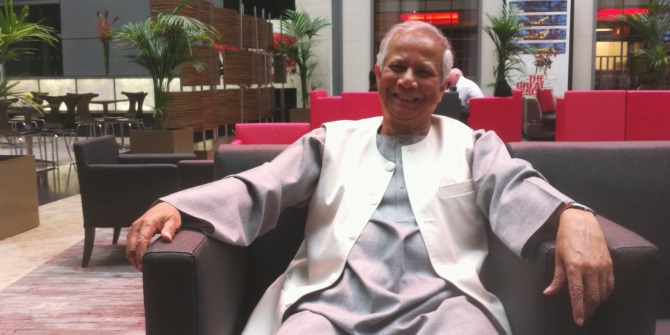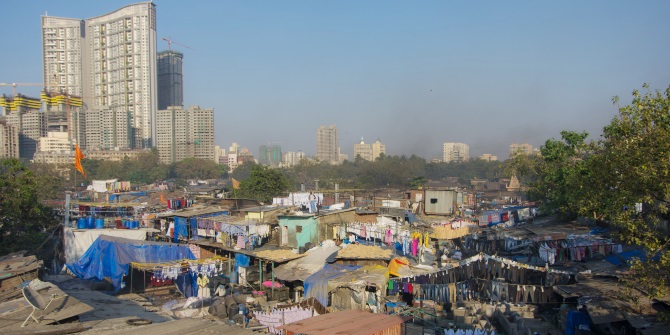 During a recent visit to LSE, microfinance pioneer Muhammud Yunus spoke to Abhishek Sundar about the weaknesses of capitalism today and the mission of microfinance to lift people out of poverty, regardless of where they live.
During a recent visit to LSE, microfinance pioneer Muhammud Yunus spoke to Abhishek Sundar about the weaknesses of capitalism today and the mission of microfinance to lift people out of poverty, regardless of where they live.
You have talked about how capitalism in its current form is incomplete. What form does the missing piece of the jigsaw take?
I say that it’s half done because at the moment it misinterprets human beings. In the capitalist system, the human being is interpreted as a money-maker who pursues his selfish interests. He is driven by self-interest and devoid of other considerations.
The point that I wanted to make is the real human being is not a robot; he’s a very independent-minded, creative person. Human beings are multi-dimensional and although selfishness is one dimension there are many others. Selflessness is also a dimension, as strong or even stronger than selfishness. So to begin with we should include selflessness in the system. Then it becomes more stable. Selfishness and selflessness are like yin and yang, one intertwines with the other one and that’s what makes it complete. That’s what the human being is.
Your discussion of selflessness leads to my next question: money can be quantified and measured, therefore people want to maximise it, but selflessness or helping others – those things can’t be measured. Isn’t that a problem?
It depends how you measure. If you have helped five poor families out of poverty, you have helped five poor people out of poverty and you can count it. Or five million, I counted it. So to say it cannot be counted is wrong, it can be counted, but not in the same way you count money.
Your counting procedure changes when you design, for example, a social business to solve the problem of malnutrition among the children. We can count how many children have been helped out of malnutrition. And you take pleasure in doing that, that yes you have done something in your life which positively touched other people’s lives. Money-making is a pleasure but changing other people’s lives is a “super-happiness”. That pleasure is never allowed in the current capitalist system, which has always been my complaint.
Turning specifically to Grameen Bank, how replicable do is it outside Bangladesh, given that it focusses on peer-pressure and a strong sense of community?
Find me any country today that doesn’t have a microcredit programme of the Grameen-type. Go to the richest country in the world, they have it. Go to the poorest country in the world, they have it. So you cannot say it can be done here but it cannot be done there.
We were invited to do set up a microfinance programme in the USA, because they were saying it cannot be done in the US. They said, we’ve tried it thousands of times, and I said you can do it a million times and you can fail. Still my conclusion that it is possible will not change. You couldn’t do it because you didn’t do it the right way. So they invited me to do it and I set up what’s called Grameen America, in late 2007. Now we have eight branches in New York City, with 25,000 borrowers, all of them are women. We just copied everything we do in Bangladesh, nothing changed. For each branch we sent a Bangladeshi employee to set it up and they do everything they did in the village in Bangladesh in New York City.
And it works. The payment rate is 99.4%. So other cities became interested and we now have branches in San Francisco, Los Angeles, Houston, Omaha (Nebraska), Charlotte (North Carolina), in Boston and so on. There are microcredit programmes in UK, in France and other European countries, all over the world.
Raghuram Rajan made the statement that microfinance exists to help the poor, and they shouldn’t be profit-driven. India and Bangladesh are culturally very similar, much more so than Bangladesh and the US, and yet microfinance has struggled in India. Why do you think that is?
It’s the same answer: it failed because people didn’t do it right. They heard about microcredit and then jumped into it without learning to do it step-by-step. It’s a skill that you have to learn and they weren’t prepared, which is why it didn’t work. Or they’ve brought new elements into it, like greed – they want to make money for themselves. Otherwise culture and everything is shared, it’s a common culture of poverty.
So do you think the solution is regulations? Because India is 142nd in the Ease of Doing Business index, we have so much red tape in our country and people are scared of the level of regulation that already exists.
Regulation comes later, it doesn’t create anything. Regulations are necessary if you create something and then it deviates from the norms, but in India the norms have not been created yet. We have been talking about regulation in Bangladesh for many years, asking the government to introduce it, to keep microcredit in shape. The only thing we were asking the government was to make a regulatory authority exclusively for microfinance. Don’t mix it up with the banking regulations. These are two different games – you cannot run one game with the rules of the other game. So finally government has done that, so we have the Independent Microfinance Regulatory Authority of Bangladesh. That’s fine.
Indian regulatory authorities have been very considerate. They have done beautiful work I must say. They stepped in when the system, the whole community was falling apart, because of the mismanagement, misinterpretation of the mission and so on. If mess is created by the practitioners the regulators have to come to put the norm into place. If the practitioners start with the norm and stick to it, regulators role is very little. They interfere only if it isn’t working.
You mentioned the norms – would you call an IPO one of those norms? You have spoken out against microfinance institutions being floated – Compartamos in Mexico, and SKS in India – why were you against this?
I said they are not microfinance. Microfinance was created to help people overcome poverty; it was not create to make money out of the poor people. These institutions misinterpreted the mission of the microfinance to begin with. They took it in another direction to make money out of it, which is where IPO and all those other things came in. As long as we can isolate the real microcredits, we will not have this problem but the difficulty is that everyone claims they are a microcredit programme. Even the loan sharks said “we are microcredit”.
Doesn’t it limit the scope if you do not access capital markets?
Grameen Bank has grown quite a bit. It’s a nationwide programme, lends out $1.5billion a year right now. It never went to the stock market, it never borrowed money from anybody. So what is the big deal? If Grameen Bank does it in Bangladesh, the same thing can be done all over India. There are now 2600 branches of Grameen Bank in Bangladesh. Each branch is independent in financials, they mobilise their own money – it’s a bank: people deposit money, they lend the money. That’s it!
Why is somebody saying we have to go to the stock market to make money? The big money is available, every village, every place you work there is plenty of money. Poor people are not asking for billions of dollars in each village, they’re asking for very tiny amounts of money. When people have the facility from the bank, they take the money to the bank as the deposit, it’s their interest, not somebody saying “you should keep your money in the bank, this helps poor people”. They do it because they get a good interest rate for their deposits and it’s convenient, it’s near where they live. We never had any shortage of money coming in, if anything we had the reverse problem of too much money, we didn’t know where to put it!
You mention lending to the poor – has the 2008 crisis affected how you look at lending, especially to the poor?
It enhanced my confidence in lending to the poor. I mentioned we started Grameen America programme in late 2007 and it worked very well. A year later the financial crisis hit. It was an amazing situation: the biggest banks in the country were collapsing but the financial crisis didn’t interfere with the flourishing of the microcredit programme, because it is not based on speculation. The banks invested in speculated stocks, the market plunged, and they were finished. The housing market crashed – finished. As long as you are close to the real economy there is no reason to collapse.
When you lend money how much do you charge? In India there is this huge debate around interest rate caps – should we have them should we not have them? It would probably stop predatory lending but banks could also stop lending all together, leaving people at the mercy of traditional lenders. How do you look at this?
I’ve been promoting a cap all along. People behave irresponsibly and it’s the only thing that can stop that behaviour. If you want to be in microcredit, accept the cap. If you cannot accept it, stay away from microcredit. So in Bangladesh we have the Microfinance Regulatory Authority and they came up with a cap of 27%, which is OK. People were also used to quoting interest rates in various ways, so customers got confused. The regulators said you have to explain it in standardised terms.
India imposed, out of this crisis that happened in Andhra Pradesh, 24% – that’s good. What should be the interest rate for microfinance in general? Usually I answer: cost of fund plus 10%. If you are in that range you are in the green zone of microcredit. You are doing very well, even if you make profit it’s OK. Cost of fund plus 10-15% then you are in the yellow zone. You are on the high side, it’s still acceptable but try to push the interest rate down to the green zone. Cost of fund plus 15% or more, you are in the red zone. You are no longer in the community of microfinance. In general it helps to understand what is meant by capping because your mission is to help poor people get out of poverty, not to make money.
Finally, I was reading Banker to the Poor recently and one of the things you mention was when you started Grameen Bank, one of the things you did was unlearn all the economic theories you had learnt at university. Is that something you would recommend to students at LSE?
It comes back to the problem that whole capitalist theory has been designed in the wrong way – you began with that question. Instead of starting with a misrepresentation of a human being, start by asking who is the human being, what does it want? How does it behave? Start with a human as a huge creative power, thinking power, independent power. Then you build your theory. You diminish a person by interpreting them in a narrow way.
View the event video and audio for the LSE entrepreneurship event A Conversation with Mahammad Yunus here.
Note: This article gives the views of the author, and not the position of the India at LSE blog, nor of the London School of Economics. Please read our comments policy before posting.
About the Authors
 Muhammud Yunus is the founder of Grameen Bank, a pioneer of Social Business and author of the bestselling Banker to the Poor. In October 2006, Muhammad Yunus was awarded the Nobel Peace Prize, along with Grameen Bank, for their efforts to create economic and social development. He was awarded an Honorary Degree of Doctor of Science (Economics) by LSE in November 2011 and in April 2013 he received the US Congressional Gold Medal.
Muhammud Yunus is the founder of Grameen Bank, a pioneer of Social Business and author of the bestselling Banker to the Poor. In October 2006, Muhammad Yunus was awarded the Nobel Peace Prize, along with Grameen Bank, for their efforts to create economic and social development. He was awarded an Honorary Degree of Doctor of Science (Economics) by LSE in November 2011 and in April 2013 he received the US Congressional Gold Medal.
 Abhishek Sundar is a CEMS Management Masters student at LSE.
Abhishek Sundar is a CEMS Management Masters student at LSE.








